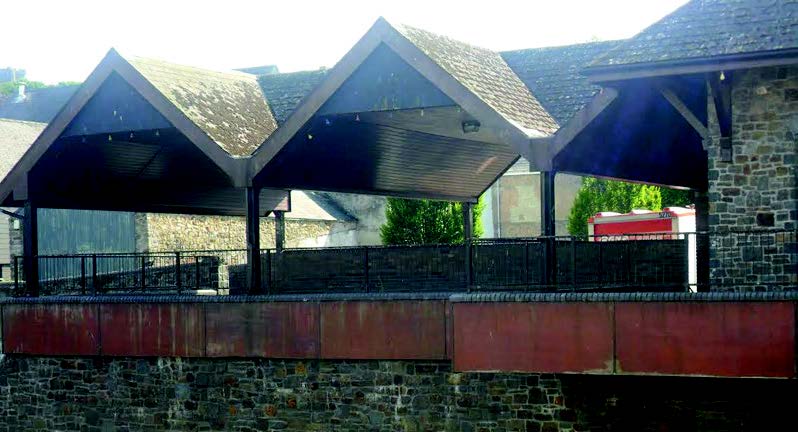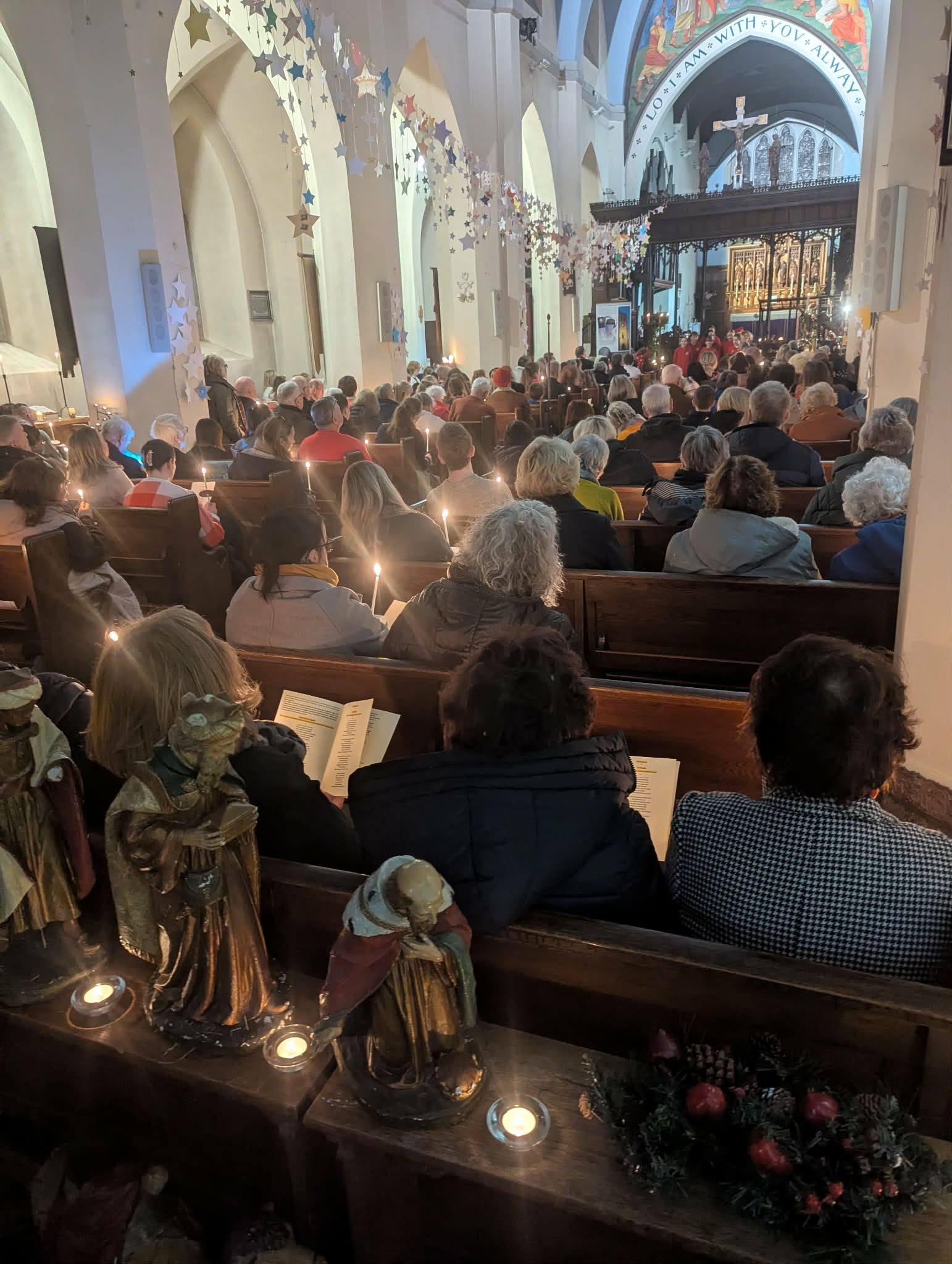News
Council criticised over Riverside plans


The Riverside Market: Showing ‘temporary’ plywood fascias
PEMBROKESHIRE COUNTY COUNCIL has been criticised over its handling of Haverfordwest Library’s relocation to the Riverside Market after it has been suggested that the projected cost of the move could be wildly inaccurate.
According to the data used to calculate the cost of relocating the library to a number of locations, the Riverside option was the cheapest in a central location. The projected total cost of works, including abnormal, came to £1,019,810.97, giving a total cost per square metre of £946.90. This compared favourably with the former site of Ocky White’s, which had a larger area, although concerns were raised about the layout. The estimated costs for work on that site came to £1,676.58 per m2.
The cost of locating the building in the North Wing of County Hall, a larger site, came out at £598.57 per m2, but it was thought that locating the library ‘out of the town centre’ at County Hall would reduce footfall in the town centre. This also applied to the Dew Street Library. A brief visit to Google Street Maps shows that County Hall is 0.3 miles from the centre of Bridge Street, with an estimated walking time of five minutes. The Library on Dew Street is also a five minute walk, though this may not take the hill into account.
It was pointed out when these figures were discussed that they were subject to further surveying work. However, The Herald has learned that a survey of the Riverside Market was in fact carried out some five years ago, when the market traders were told that thebuildingneeded £1.3m of necessary works carried out, in addition to £1.7m worth of desirable works.
Bearing in mind that this survey is five years old, and that no major works have taken place in this time, it would be reasonable to assume that the fabric of the building has deteriorated further, meaning the costs could be even higher. Our reporter was told that the structural steel over the river was meant to be painted every five years. This task had been carried out once, around 20 years ago. When the fascias were removed for the steel to be painted some years ago, the metal was said to be in too poor a condition to paint. A temporary plywood cladding was installed, and remains to this day. Our reporter was shown a number of sites where the roof was leaking – apparently an ongoing problem.
In a meeting held with traders a week before the library relocation was discussed by the cabinet, Michael Cavanagh of the Cultural Services Department is said to have told representatives of the market committee that the actual cost of the works would be double what was quoted.
If we assume that all of the £1.7m of ‘desirable’ work would have been undertaken with the idea of improving the Riverside as a retail venue – by no means a given – and therefore does not apply to the redevelopment of the venue as a library, then this still leaves £1.3m of ‘necessary’ work. This generous assessment, when added to the original estimate, would lead to a figure of £2,319, 810.97, or £2,153 per m2. It is possible that some of the work could be counted twice, though as it was explicitly pointed out that further surveying was needed when the report was presented in January, this seems unlikely.
When the Herald asked Pembrokeshire County Council about this, we were told that the previous survey was ‘historic’, and ‘was not prepared for the same purpose or on the same basis. It was undertaken in the context of a major redevelopment proposal for the town centre’.
Regarding the projected costs a council spokesman said: “ As part of the options appraisal work that led to the Riverside Market being identified as the best location for a new County Library and Information Centre, external Quantity Surveyors provided an estimate of £1,019,810.97. However, this did not include some costs that we anticipate may be required as part of the development, such as replacement of the roof. It also did not include costs associated with relocating the market traders. The full costs of the scheme cannot be identified until the project brief has been finalised, and this work is currently underway as stated in the recent Cabinet report.”
We were also told that the Cultural Services Department had been aware for some time that the costs would by far exceed this figure, and had been told that £2.3m was available for the project.
The earlier assertion that the Riverside Market had not received any major works in recent years was based on talks with many of the traders, who expressed their dissatisfaction with the council’s management of the market, especially in the last 18 months since the plans for relocating the library were first discussed.
It was claimed by more than one person that the council’s treatment of the market over that period amounted to a managed decline, or ‘death by a thousand cuts,’ as one stallholder memorably put it. Half of the market has been empty for some time. Another stallholder said that reports in local media claiming that the market’s closing was only a matter of time when the issue was first raised had meant that people were unwilling to take on any of the vacant units. They added that no particular effort seemed to have been made by the council to fill any of the vacant units. These have now been blocked off by barricading one of the walkways.
This perceived mismanagement has affected the businesses of all the traders we talked to. The Herald was informed that eighteen months ago, when the relocation plans were first discussed, the market had 95% occupancy, which compared very favourably to Haverfordwest town centre as a whole. This has nosedived since – apparently as a result of traders moving elsewhere due to uncertainty about the market’s future, and new traders being unwilling to move in because the council was unwilling to give long-term assurances. The large number of vacant premises and the appearance of the market have both undoubtedly contributed to significantly reduced footfall.
The council has said that help will be given to traders looking to relocate, including two years of business rates relief. This does not take into account the paucity of ‘like for like’ premises in the town centre, which would mean that established businesses would have to move away from their client bases. Apparently, businesses moving to larger premises would receive less assistance. It can be assumed that this would be classified as business expansion rather than the lack of a more suitable property.
The Council was keen to clarify this issue: “The relocation package is on a like-for-like basis so if a trader elects to take a larger unit, the Council will provide support based on a similar-sized unit. This is not a reduced level of financial assistance, it is an apportioned level of assistance.”
Traders expressed their concerns about suitable properties available, and the lack of communication from the council. One trader told us that a ‘mini market’ had been considered for Bridge Street, and that four properties had been viewed. However, no further details had been made available, leading some of the businesses to accuse the council of not answering basic questions pertaining to their future.
As has been pointed out, the uncertainty surrounding the market has led to decreased trade. This has meant that some businesses have found themselves in rent arrears. The council has told businesses in arrears that they face eviction if the money is not paid soon, and that they will not be entitled to any assistance with relocation. Whether or not the council has been honouring the terms of the rental agreement by allowing the market to deteriorate is another question.
Community
Community gathers to remember Corrina Baker

Lanterns and balloons released in emotional acts of remembrance
FAMILY, friends and members of the local community came together to remember Corrina Baker at a series of moving events held across west Wales this week.
Corrina’s funeral took place on Monday (Dec 15), a month after her death, with a public service held at St Mary’s Church. Mourners lined the route as her coffin was carried on its final journey in an elegant horse-drawn carriage, before a private cremation later took place at Parc Gwyn crematorium in Narberth.

Later that evening, shortly after 6:00pm, friends and relatives gathered at the Quayside in Cardigan for the first of two acts of remembrance to celebrate her life. Lanterns were lit and released into the night sky above the town as some of Corrina’s favourite songs were played.






On Tuesday afternoon (Dec 16), a second tribute was held near the location where Corrina was found. Twenty-one pink balloons — one for each year of her life — were released into a clear blue sky, each carrying personal messages in her memory.
Floral tributes continue to be laid at the Netpool, while a GoFundMe appeal set up in Corrina’s memory has raised more than £2,300. She has been described by those who knew her as “funny and bright”.
Dyfed-Powys Police have confirmed that their investigation into the circumstances surrounding Ms Baker’s death is ongoing. A 29-year-old man who was arrested on suspicion of murder has been released on bail while inquiries continue.
(Photos: Stuart Ladd/Herald)









Community
Six untaxed vehicles seized in Milford Haven police operation

SIX untaxed and abandoned vehicles were seized during a joint roads policing operation in Milford Haven on Tuesday morning.
Officers from the Milford Haven Neighbourhood Policing and Prevention Team (NPPT) worked alongside the Pembrokeshire Roads Policing Team as part of targeted enforcement across the town.
In addition to the vehicle seizures, a number of traffic offence reports were issued to drivers during the operation.
Police said the action formed part of ongoing efforts to improve road safety and tackle vehicle-related offences in the Milford Haven area.
Community
Candlelit carol service brings community together in Milford Haven

ST KATHARINE and St Peter’s Church in Milford Haven hosted its annual Candlelit Festival of Nine Lessons and Carols, bringing together members of the community for a traditional celebration of Christmas.
The service featured readings from the Mayor of Milford Haven, representatives of the Soroptimists, Milford Haven Amateur Operatic Society, the Headteacher and Head Prefects of Milford Haven School, Milford Haven Town Band, and NCI Wooltack Point.
Music for the evening was provided by organist Seimon Morris, Milford Haven Town Band and the Milford Haven Cluster Band, whose performances added to the atmosphere of the candlelit service.
The Friends of St Katharine and St Peter’s Church thanked all those involved and wished the community a happy Christmas.

-

 Crime11 hours ago
Crime11 hours agoMilford Haven man jailed after drunken attack on partner and police officers
-

 News3 days ago
News3 days agoDyfed-Powys Police launch major investigation after triple fatal crash
-

 Crime2 days ago
Crime2 days agoMan sent to Crown Court over historic indecent assault allegations
-

 Crime1 day ago
Crime1 day agoMan charged with months of coercive control and assaults
-

 Crime4 days ago
Crime4 days agoMan spared jail after baseball bat incident in Milford Haven
-

 Crime2 days ago
Crime2 days agoMilford Haven man admits multiple offences after A477 incident
-

 Crime10 hours ago
Crime10 hours agoTeenager charged following rape allegation at Saundersfoot nightclub
-

 Education7 days ago
Education7 days agoTeaching assistant struck off after asking pupil for photos of her body




















sjb
August 20, 2015 at 10:56 pm
Pembrokeshire County Council criticised AGAIN?
I DO NOT BELIEVE IT ;-(